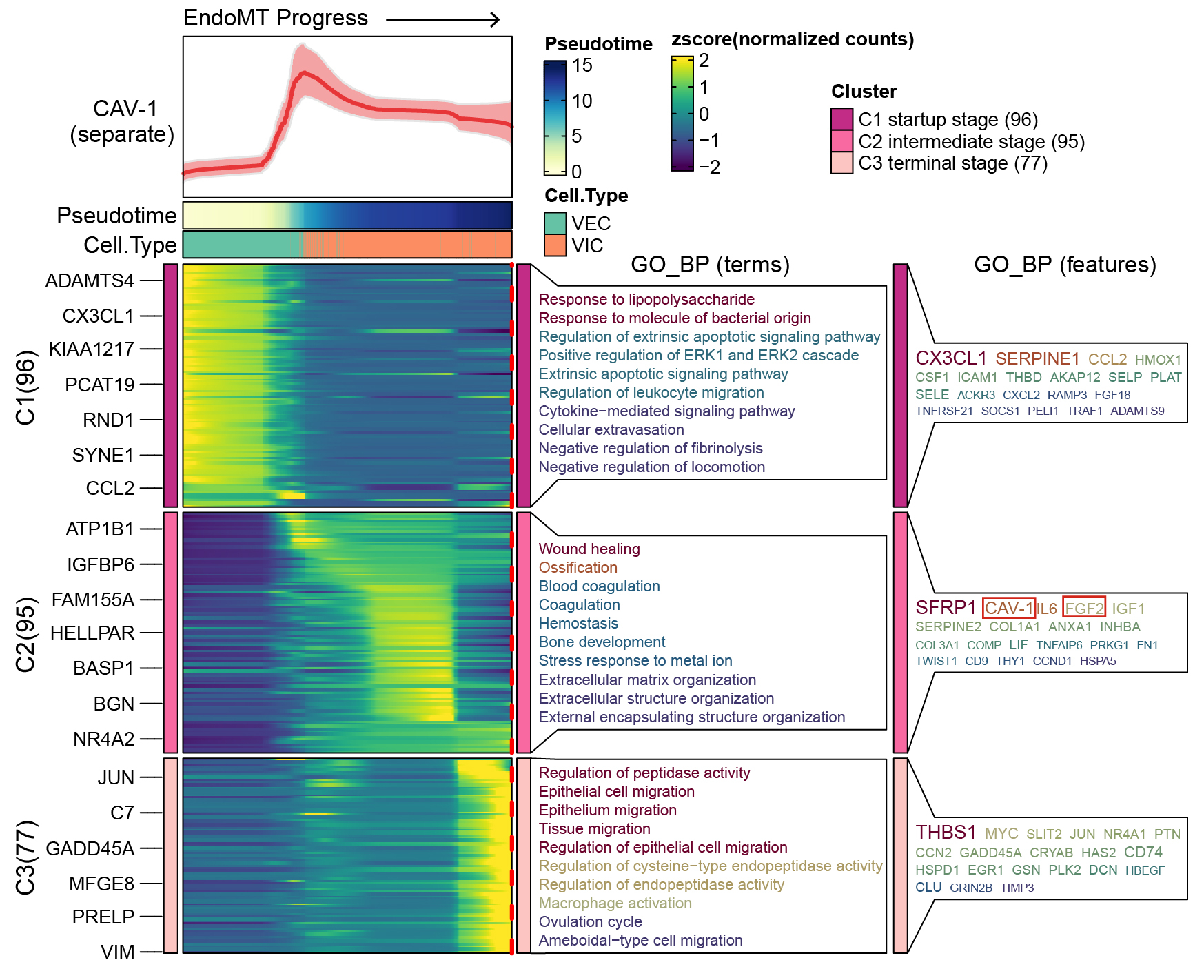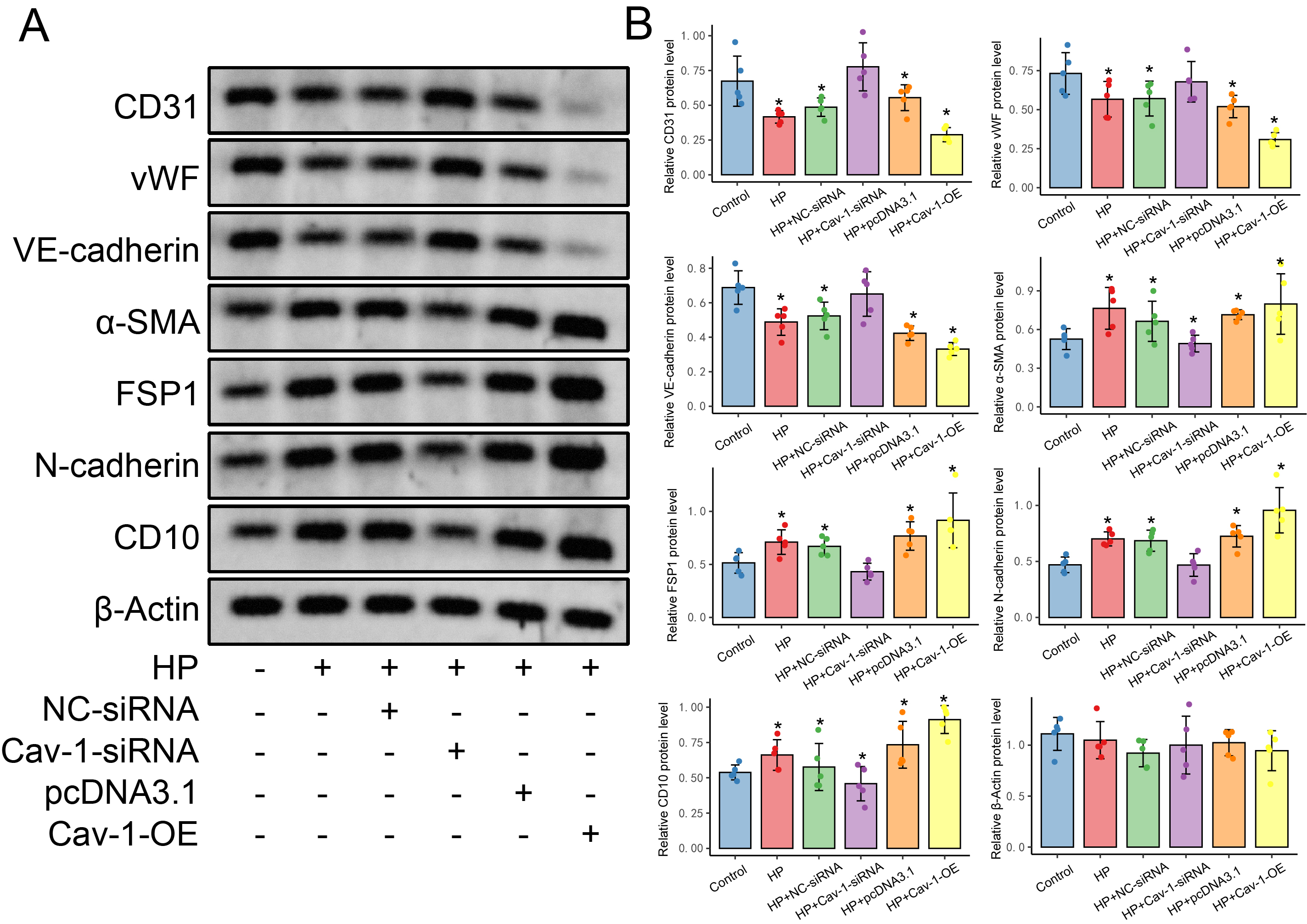Final ID: MDP41
Cav-1/FGF2 Axis Mediates Endothelial-Mesenchymal Transition Promoting Aortic Valve Calcification
Abstract Body (Do not enter title and authors here): Background
Calcific Aortic Valve Disease is a common cardiac condition with no effective medication available; severe cases require surgery. Endothelial-to-mesenchymal transition is a key pathological process, yet the genetic regulatory mechanisms involved remain unclear.
Research Questions
Investigating the mechanism of Cav-1/FGF2 axis-mediated endothelial-mesenchymal transition in aortic valve calcification.
Methods
Histopathology, immunohistochemical staining, and western blot analysis were performed on 5 non-calcified and 5 calcified aortic valves. Proteomic sequencing was conducted on these samples. Single-cell RNA sequencing on 3 calcified aortic valves focused on valve endothelial and interstitial cells to explore key genes and functions in EndoMT. In vivo and in vitro experiments, along with single-cell multi-omics sequencing, elucidated the role and mechanism of the Cav-1/FGF2 axis in EndoMT using endothelial cell-specific EndoMT knockout mouse models and cell models.
Results
Proteomics and single-cell sequencing results indicated that Cav-1 is involved in the Endothelial-to-mesenchymal transition process in Calcific Aortic Valve Disease. Cav-1 plays a crucial role in the intermediate transition of EndoMT, interacting significantly with FGF2. Immunohistochemical staining showed high expression of Cav-1 in calcified aortic valves. In vitro experiments demonstrated that Cav-1 mediates Endothelial-to-mesenchymal transition in valve endothelial cells, promoting aortic valve calcification. Molecular docking analysis revealed potential direct interaction between Cav-1 and FGF2 proteins. Elevated Cav-1 gene expression increases the number of cell surface caveolae, enhancing cell surface area, which promotes FGF2 binding to its receptor and activates the TGF-beta receptor, both of which facilitate EndoMT through the Smad pathway.
Conclusion(s)
Activation of the Cav-1/FGF2 axis promotes endothelial-mesenchymal transition, thereby promoting aortic valve calcification.
Calcific Aortic Valve Disease is a common cardiac condition with no effective medication available; severe cases require surgery. Endothelial-to-mesenchymal transition is a key pathological process, yet the genetic regulatory mechanisms involved remain unclear.
Research Questions
Investigating the mechanism of Cav-1/FGF2 axis-mediated endothelial-mesenchymal transition in aortic valve calcification.
Methods
Histopathology, immunohistochemical staining, and western blot analysis were performed on 5 non-calcified and 5 calcified aortic valves. Proteomic sequencing was conducted on these samples. Single-cell RNA sequencing on 3 calcified aortic valves focused on valve endothelial and interstitial cells to explore key genes and functions in EndoMT. In vivo and in vitro experiments, along with single-cell multi-omics sequencing, elucidated the role and mechanism of the Cav-1/FGF2 axis in EndoMT using endothelial cell-specific EndoMT knockout mouse models and cell models.
Results
Proteomics and single-cell sequencing results indicated that Cav-1 is involved in the Endothelial-to-mesenchymal transition process in Calcific Aortic Valve Disease. Cav-1 plays a crucial role in the intermediate transition of EndoMT, interacting significantly with FGF2. Immunohistochemical staining showed high expression of Cav-1 in calcified aortic valves. In vitro experiments demonstrated that Cav-1 mediates Endothelial-to-mesenchymal transition in valve endothelial cells, promoting aortic valve calcification. Molecular docking analysis revealed potential direct interaction between Cav-1 and FGF2 proteins. Elevated Cav-1 gene expression increases the number of cell surface caveolae, enhancing cell surface area, which promotes FGF2 binding to its receptor and activates the TGF-beta receptor, both of which facilitate EndoMT through the Smad pathway.
Conclusion(s)
Activation of the Cav-1/FGF2 axis promotes endothelial-mesenchymal transition, thereby promoting aortic valve calcification.
More abstracts on this topic:
AI-driven Aortic Valve Calcification Measurement in Coronary Artery Calcium Scan Detects Aortic Stenosis Comparably to Human Experts: An AI-CVD Study within the Framingham Heart Study
Naghavi Morteza, Atlas Kyle, Zhang Chenyu, Reeves Anthony, Atlas Thomas, Wasserthal Jakob, Yankelevitz David, Henschke Claudia, Wong Nathan
A Meta-Analysis Comparing Same-Day Discharge to Later-Day Discharge in Transcatheter Aortic Valve ReplacementJain Hritvik, Passey Siddhant, Jain Jyoti, Goyal Aman, Wasir Amanpreet, Ahmed Mushood, Patel Nandan, Yadav Ashish, Shah Janhvi, Mehta Aryan


